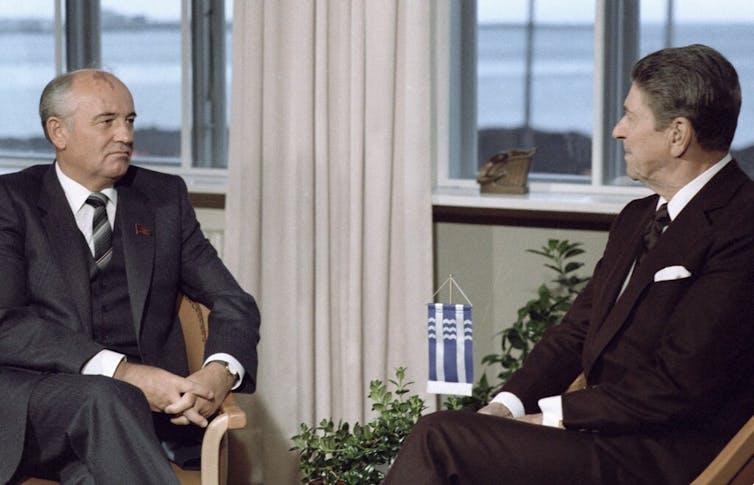Donald Trump has unveiled plans for a new “next-generation” missile defence system which he says will by “capable even of intercepting missiles launched from the other side of the world, or launched from space”. The US president says “Golden Dome”, which is reportedly partly inspired by Israel’s Iron Dome system that protects the country from missile attacks, will be operational by the end of his current four-year term of office.
But critics say that it’s much harder to design a defence system to protect a land mass the size of the United States. This is particularly the case in an era characterised by the threat from hypersonic missiles, such as those used by Russia against Ukraine, as well as attacks from space.
Ever since the first aerial attacks on civilian populations, there have been increasing calls to provide systems that can defend and destroy the potential for an adversary to attack people, governments and infrastructure.
This developed from relatively basic defence systems, such as those employed by the UK from 1917 to protect London and the south-east of England from attack during the first world war, which developed further to provide a relatively large degree of protection during the Battle of Britain in the summer and autumn of 1940.
Get your news from actual experts, straight to your inbox. Sign up to our daily newsletter to receive all The Conversation UK’s latest coverage of news and research, from politics and business to the arts and sciences.
During the cold war, which followed the dropping of atomic bombs on Japan in 1945, research accelerated globally into ways of providing greater protection against nuclear attack. The most eye-catching of these ideas was the announcement by Ronald Reagan in 1983 of plans to develop a massive (and hugely expensive) land and space-based missile defence system.
The project, officially called the Strategic Defence Initiative quickly became known colloquially – if slightly mockingly – as “Star Wars”.
The concept behind the missile defence system was that it would provide a way of effectively making nuclear weapons obsolete. Through the application of a defensive system that incorporated both land and space-based missiles, it was believed that any nuclear warhead fired would be destroyed before it was able to re-enter the Earth’s atmosphere.
This would not only prevent intercontinental ballistic missiles from striking their intended target, but their destruction so high above the Earth would mean that they would not pose a threat in terms of nuclear radiation and fallout.
It’s important to note that what was announced by Reagan in March 1983 was not about the development, construction or application of an actual defensive system. It was about funding research into the technologies that would be required for such a system.
Reagan claimed this was a move to create a more peaceful world by making nuclear weapons effectively obsolete. But it was certainly not seen this way in Moscow.
It was also something of a half truth. The move should be seen within the wider context of cold war relations and developments. The Reagan administration was seeking to bring the Soviet Union to the negotiating table to discuss reductions in strategic weapons.
By developing a defensive system that would make strategic nuclear weapons almost obsolete, it was hoped this would force the hand of the Soviets and effectively compel them to agree to talks.

But at the same time, as far as the decision-makers in the Kremlin were concerned, such a system – if developed and deployed – would give the United States a colossal strategic advantage. By the mid-1980s, it was highly unlikely that the Soviets could ever afford the investment in research and development and production capabilities to design their own system. This would mean that the Soviet Union was now highly vulnerable to a nuclear attack, while the US would be protected.
This would place the United States in a similar position to that which it had enjoyed between 1945 and 1949, when it was the only nation that had the ability launch nuclear weapons. The theory of mutually assured destruction would fall almost overnight, meaning that the US had very little to fear from launching a nuclear attack, as any Soviet response would be futile.
Given the potential for nuclear blackmail by the all-powerful US, it might cause the Kremlin to consider launching a pre-emptive strike against the US before such a system could be developed or implemented. Rather than making the world a safer place and diminishing the place of nuclear weapons, the world would become more dangerous.
Pie in the sky?
The Strategic Defence Initiative never really got off the ground. The initial mockery from large parts of the public of the US hid many real challenges to the development of such a defensive system. The research and development aspect alone came with a very large price tag. This was largely out of step with Reagan’s ideas about small government and limited public spending.
In order to fund such a programme, money would have to be diverted from other domestic and social programmes, such as health and education. Despite the cold war context, this may well have risked unrest and protest from large swaths of the US population.
The new technologies that were supposed to be developed as a part of this initiative were untested. It became evident that the only real way to test the efficacy and capability would be to expose the world to a nuclear attack and hope that the theoretical concepts that had been developed actually worked in practice.
The Soviet Union also found ways of countering the potential developments that may emerge from the Strategic Defence Initiative, making the system almost redundant before it had begun.
Proposed defence systems, like the Strategic Defence Initiative or the Golden Dome, can appear to be a panacea to defensive worries caused by heavily armed adversaries. Announcements about their development can cause global headlines and speculation about what this means for relations between nations and the international system.
Take a step back from the US president’s hype, however, and it’s clear that Golden Dome will be hugely expensive and challenging to operate. Moreover it will require significant capabilities that do not yet exist and have yet to be tested operationally.
Matthew Powell does not work for, consult, own shares in or receive funding from any company or organisation that would benefit from this article, and has disclosed no relevant affiliations beyond their academic appointment.
This article was originally published on The Conversation. Read the original article.







